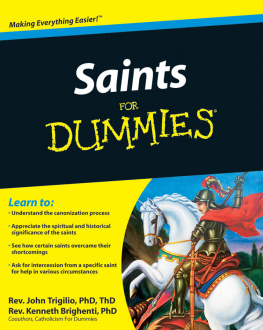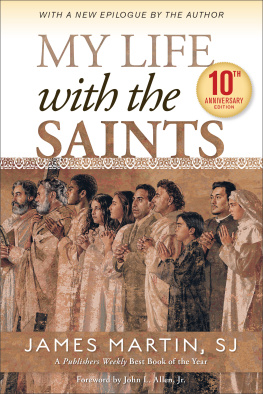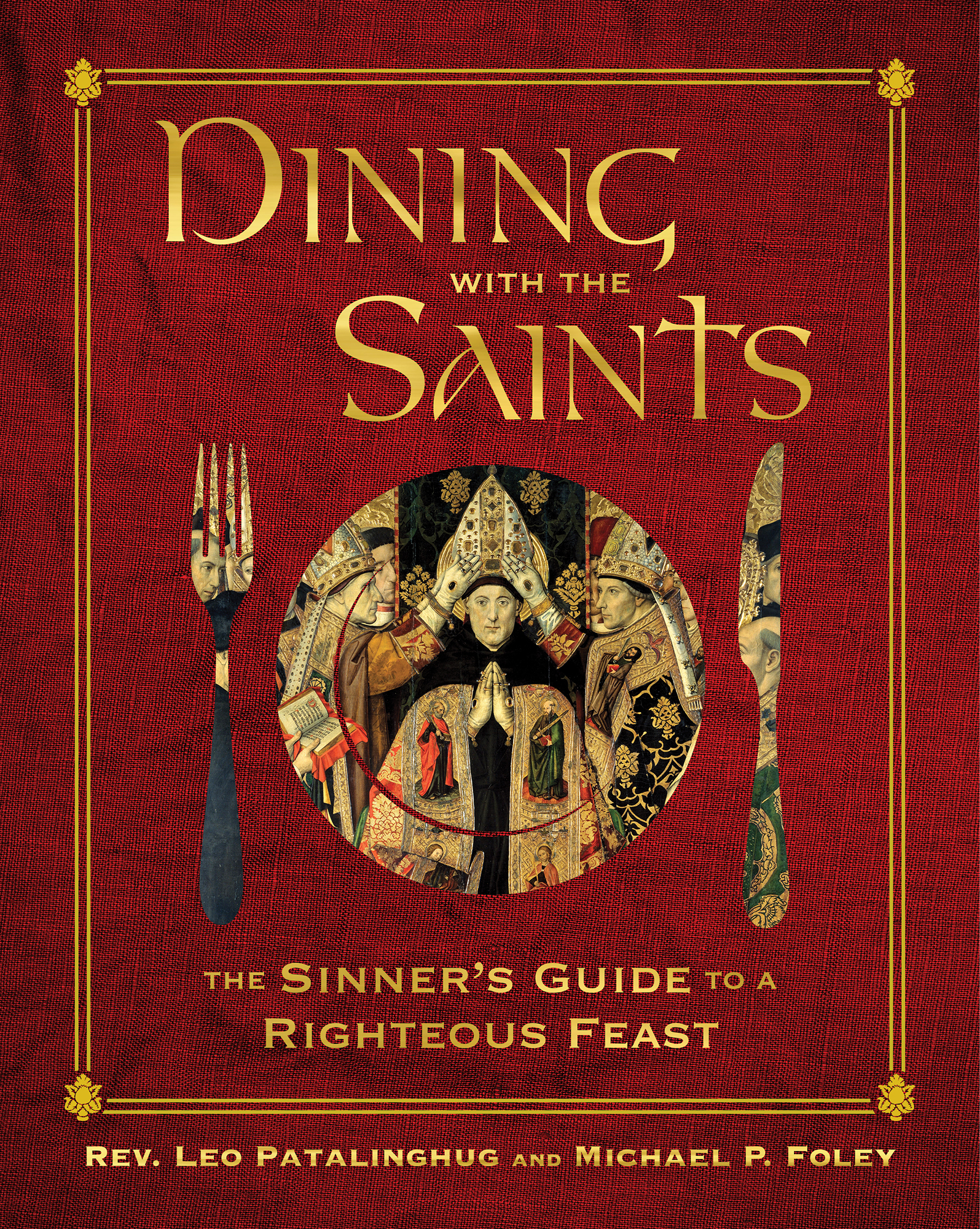Contents
Guide
Dining with the Saints
The Sinners Guide to a Righteous Feast
Rev. Leo Patalinghug and Michael P. Foley

This book is dedicated to the saints who feasted with, fasted for, and faithfully served Gods hungry flock.
May all who read this book and prepare these recipes hunger for what God wants, here on Earth and especially in Heaven.
INTRODUCTION

AND EVERY THING THAT MOVETH AND LIVETH SHALL BE MEAT FOR YOU: EVEN AS THE GREEN HERBS HAVE I DELIVERED THEM ALL TO YOU.
Genesis 9:3
IT IS BETTER TO BE INVITED TO HERBS WITH LOVE, THAN TO A FATTED CALF WITH HATRED.
Proverbs 15:17
T HE W HENCE AND W HY OF T HIS B OOK
S ome matches are made in Heaven, some on earth, and some in both places. When the powers that be at Regnery Publishing suggested that we, Fr. Leo Patalinghug and Dr. Mike Foley, team up to write Dining with the Saints: The Sinners Guide to a Righteous Feast, they created a worldly partnership with a celestial aim. Father Leo is an award-winning chef, author, a popular radio and TV host, and founder of Plating Grace, a fun, family-focused, dynamic ministry seeking to bring about a future of stronger families, closer relationships, and a deeper understanding of Jesus as Food for our minds, bodies, and souls. Mike is the author of three bestselling liturgical cocktail books (Drinking with the Saints, Drinking with Saint Nick, and Drinking with Your Patron Saints) and an authority on the feast days of the Church. For the sake of food, festivity, and family, we are pleased to present to you this book, the product of our labors in the Lords kitchen, library, and chapel.
And perhaps just in time. In the United States, family dinnersand with them, family conversationhave dropped alarmingly in the last couple of decades, the results being increased substance abuse, unwanted pregnancies, depression, obesity, lower academic performance, smaller vocabularies, and reduced literary skills among children and poorer mental and physical health and higher divorce rates among adults. We fear that the loss of the family dinner will also have a bad effect on the very source and summit of our worship. If the Eucharist is, as we Catholics believe, both a sacrifice and a banquet, what will happen to our understanding of the Blessed Sacrament when we no longer understand the simple activity of a shared meal? What will happen to our appreciation of a solemn sacrifice when we lose even the simple etiquette of the table? Perhaps to Father Patrick Peytons wise aphorism The family that prays together stays together we should add, The family that dines together shines together.
T HE U NIQUENESS OF T HIS B OOK
Dining with the Saints gives you the resources you need for a healthy and uplifting family meal, a memorable couples night, or a merry dinner party. It stands humbly in a long line of fine religious-themed cookbooks, beginning with Florence Bergers 1949 classic Cooking for Christ. But our book differs from its predecessors in three respects.
First, like the householder in the Gospel, Dining with the Saints brings out of the storeroom treasures both new and old (see Matthew 13:52). Some Catholic cookbooks favor only traditional recipes; others have only novel suggestions; ours aspires to the perfect blend of both. We delight in introducing you to the vast and wonderful array of old folk dishes from around the world, but we also realize that not all of these are feasible today. For instance, there is a tradition of having sheeps head on Saint Andrews Day. Since eating something that looks like a slightly mummified head staring at you with eyeless sockets would be about as attractive to the average American family as finding half a worm in an apple, we provide a more edible alternative. In fact, all of the recipes in this book are specially designed by Father Leo himself to be delicious, easy to make, and a good fit for the liturgical occasion.
Second, whenever possible, Dining with the Saints presents what a saint actually ate or a piece of advice he or she gave about eating and drinking, and we connect that information to our recipes. Saint Thomas Aquinass miracles having to do with food all involve fish, and so we recommend a delicious pasta with cod for his feast. Geneva bishop Saint Francis de Sales worried about spicy food upsetting ones spiritual equilibrium, and so to honor him there is a mild Swiss potato rosti. Granted, not all the saints were merry souls when it came to feasting. Saint Isidore of Alexandria (d. 403) frequently burst into tears at table, saying, I who am a rational creature, and made to enjoy God, eat the food of brutes, instead of feeding on the bread of angels. You may be surprised to learn that Saint Isidore was not invited to a lot of dinner parties.
Third, Dining with the Saints has a special Food for Thought feature that will help you profit spiritually from the occasion. A meal in honor of Saint Benedict is also a reminder that the Benedictine motto Pray and Work is not just for monks but for everyone; and dinner on the feast of Saint Anthony of Padua is an opportunity to find your faith in times of despair and your courage in times of fearnot just your lost car keys.
P RACTICAL A DVICE
First, do not be scrupulous about preparing meals on the appointed day. Instead, think of these entries as a moveable feast and transfer them to whenever it is most convenient. And be creative with the calendar. Like Drinking with the Saints and its sequels, this volume follows the old 1962 Roman calendar (which has more feast days); the traditional dates appear in boldface, followed by dates in italics for the Novus Ordo calendar if they differ from the traditional dates. Consult the appendix for cross-referencing, and be opportunistic with both calendars, landing on what works for you and your family. Finally, feel free to mix and match. Sometimes the entry for the day is only a dessert or a dipping sauce. Pair this with other entries to come up with a complete banquet (and for adult beverages, turn to Drinking with the Saints). The important thing is to carve out special time for the refreshment of body and soul and for the enjoyment of each others company.
Second, just as it does not take much to turn the carnal fueling of the body known as eating into the exercise of civility known as dining (all you need are table manners and polite conversation), so too it does not take much to turn an exercise of civility into an almost sacred moment of fellowship and good cheer. We recommend starting off by saying a prayer before and after you sup. We include below the traditional Grace before Meals. You can, of course, improvise a prayer of your own, but dont go on for too long or the food will get cold, and dont forget to bless the food. Lay persons have the power to bless two things, their families and their comestibles; a blessing extends the peace and goodness of the Incarnate Word to other incarnate things, such as the things that are about to go into our mouths.
While most Catholics know the standard Grace before Meals, few know the Grace after Meals (see below). The first prayer blesses the food, the second gives thanks for it. We find the arrangement mildly amusing: while Protestants usually offer a thanksgiving before the meal, Catholics dont thank God for the food on their table until theyve finished it! (Cynical, perhaps?) But the prayer reminds us to be thankful not only for the food we have just enjoyed but for







![Catholic Way Publishing [Publishing - The Saints Collection [2,428 Saints]](/uploads/posts/book/131283/thumbs/catholic-way-publishing-publishing-the-saints.jpg)



